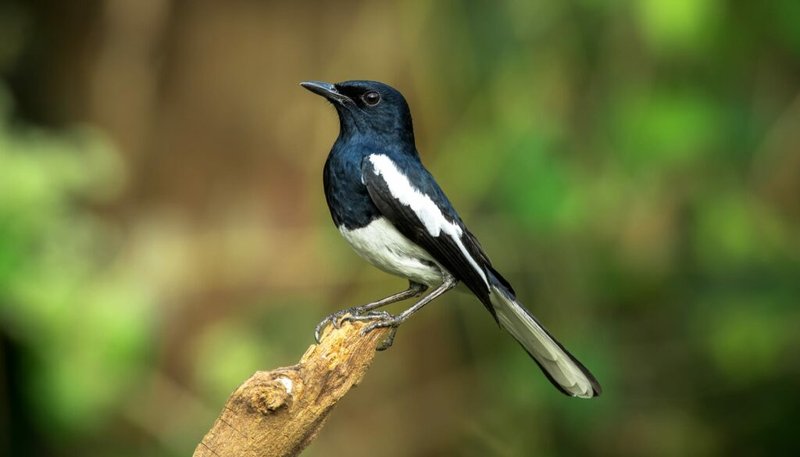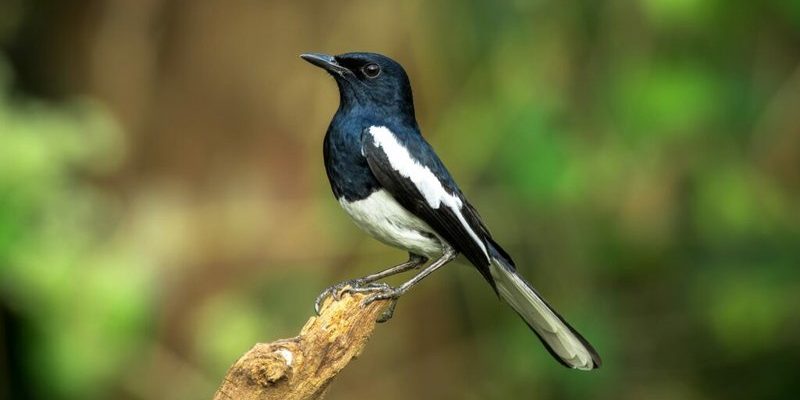
The Oriental Magpie Robin, with its charming song and striking appearance, brings a touch of elegance to various landscapes. Also known as the Copsychus saularis, this bird is a favorite among birdwatchers and nature lovers. Imagine stepping into a garden filled with vibrant flowers and lush greenery, only to be serenaded by the melodious tunes of this enchanting creature. It’s like nature’s way of reminding us to pause and appreciate the beauty around us.
What makes the Oriental Magpie Robin particularly fascinating is not just its looks, but also its behavior and adaptability. Found across different regions in Asia, this small bird showcases a range of colors and patterns that can make even the most seasoned ornithologist stop and gawk. So, whether you’re a birdwatching newbie or an experienced enthusiast, there’s so much to discover about this delightful species.
Physical Characteristics
The Oriental Magpie Robin is a small to medium-sized bird featuring a unique and attractive plumage. Typically, adult males exhibit a glossy black upper body with a bright white belly that contrasts beautifully. Females, on the other hand, have a more muted coloration, leaning towards a brownish hue with a softer white underside. This difference in coloration not only adds beauty but also plays a role in their mating rituals. Size-wise, these birds generally measure around 19-23 cm in length, which is about the size of a small sparrow.
A notable feature of this bird is its long tail, which it often flips up and down as it hops around on the ground or perches on branches. This tail movement is not just for show; it might serve as part of their communication strategy. The sleek body is complemented by a sharp, pointed bill that’s perfectly designed for catching insects and other small food items. The overall appearance of the Oriental Magpie Robin exudes a certain charm, making it easily recognizable.
Habitat and Distribution
You’ll find the Oriental Magpie Robin in a variety of habitats, from urban areas to rural gardens, and even in the dense forests of Southeast Asia. They seem to thrive in places where trees are plentiful, offering the ideal spots for nesting and shelter. These birds are particularly fond of open woodland, scrub, and edges of forests, where the undergrowth is rich in insects—one of their primary food sources.
From India to China and down to Indonesia, the Oriental Magpie Robin has a wide distribution. This adaptability to different environments is impressive. In cities, they’ve learned to navigate our landscapes, often seen hopping about in parks or gardens, seeking food. You might even spot one flitting around your local backyard, its striking plumage contrasting against the greenery.
Diet and Feeding Habits
When it comes to food, the Oriental Magpie Robin is an opportunistic feeder. They primarily feast on insects, spiders, and other small invertebrates, which they catch with remarkable agility. Their diet can also include fruits and berries, especially during the breeding season when they require extra energy. Feeding strategy is quite interesting; they often employ a method of foraging that involves hopping around on the ground or low branches, scanning for movement.
Here’s the thing: you might often see them performing this delightful little dance as they scratch around in leaf litter or on the ground. This behavior not only helps them find food but also adds a playful quality to their character. They are known to be quite tenacious and won’t hesitate to chase off larger birds if they feel their food source is threatened.
Breeding and Nesting
The breeding season for the Oriental Magpie Robin generally occurs between March and August, although this can vary depending on the region. During this time, male birds become especially vocal, using their beautiful songs to attract mates. It’s like they’re putting on a concert, with the hopes of winning over a partner. Building a nest is often a joint effort, with females selecting the perfect site—usually in a tree hollow, bush, or even in man-made structures.
The female typically lays about 3-6 eggs, which are a lovely shade of pale blue or green with speckled markings. Both parents are involved in caring for the young, which is heartwarming to see. After about 14 days, the eggs hatch, and the parents work tirelessly to feed their chicks. The sight of small, fluffy birds being fed by attentive parents is a delightful reminder of the kindness found in nature.
Behavior and Social Structure
Oriental Magpie Robins are known for their inquisitive and social nature. They often forage in pairs or small groups, which allows them to better spot potential threats. You might notice them engaging in playful interactions, flitting from branch to branch, or even chasing each other in a friendly game. Their social structures can also include interactions with other bird species, especially when it comes to sharing food sources.
In terms of communication, these birds are quite vocal. Their songs vary from sweet melodies to sharp calls, each serving a different purpose. Males, during the breeding season, can often be heard belting out tunes to establish territory and attract mates. It’s like having a backyard concert—imagine opening your window to a beautiful morning serenade! Their ability to mimic sounds and songs from other species adds another layer of charm to their personality.
Conservation Status
The Oriental Magpie Robin is currently classified as a species of “Least Concern” by the IUCN. This means they are relatively common and stable across much of their range. However, habitat loss due to urbanization and deforestation poses a threat to their populations in certain areas. Conserving green spaces in urban environments can significantly help these lovely birds continue to thrive.
Bird watchers and nature lovers play a crucial role in their conservation. By creating bird-friendly gardens and encouraging local flora, we can help sustain their habitats. Additionally, raising awareness about the importance of preserving natural landscapes will ensure that future generations can still enjoy the beauty of the Oriental Magpie Robin.
Interesting Facts
| Common Name: | Oriental Magpie Robin |
| Scientific Name: | Copsychus saularis |
| Size: | 19-23 cm (7.5-9 in) |
| Weight: | 25-30 g (0.88-1.06 oz) |
| Habitat: | Urban areas, gardens, forests |
| Diet: | Insects, fruits, berries |
| Wingspan: | 22-25 cm (8.7-9.8 in) |
FAQ
What do Oriental Magpie Robins eat?
Oriental Magpie Robins primarily feed on insects, spiders, and other small invertebrates. During fruiting seasons, they also enjoy berries and small fruits. Their diet varies based on availability, allowing them to thrive in diverse environments. This adaptability is one reason they can be found in both urban and rural settings.
Where can I find Oriental Magpie Robins?
You can spot Oriental Magpie Robins in a range of habitats, including gardens, parks, and forests across Asia. They are commonly found in Southeast Asian countries like India, Indonesia, and Malaysia. If you’re looking to observe them, try visiting green spaces where they might be foraging or singing.
Are Oriental Magpie Robins migratory?
Oriental Magpie Robins are generally resident birds, meaning they don’t migrate long distances. However, some local populations may move to lower altitudes or different areas during the non-breeding season, depending on food availability and environmental conditions. This movement allows them to adapt to changing habitats.
How can I attract Oriental Magpie Robins to my garden?
To attract Oriental Magpie Robins, create a bird-friendly habitat by providing native plants, bushes, and trees. Ensure there are plenty of insects and fruits available for them to feast on. You can also set up birdbaths for water and nesting boxes to encourage them to take up residence in your garden.
Do Oriental Magpie Robins sing all year round?
While they are most vocal during the breeding season, Oriental Magpie Robins do sing throughout the year. Their songs are not just reserved for attracting mates; they also use vocalizations to establish territory and communicate with other birds. The melodious tunes are a hallmark of their presence.
What is the lifespan of an Oriental Magpie Robin?
In the wild, Oriental Magpie Robins typically have a lifespan of 2 to 5 years, although some individuals may live longer under favorable conditions. Factors such as habitat quality, food availability, and predator presence significantly impact their survival, just like in many other bird species.
Is the Oriental Magpie Robin a good singer?
Absolutely! The Oriental Magpie Robin is celebrated for its melodious singing abilities. Males perform complex songs that can be quite beautiful, especially during courtship. Their vocal talents not only charm potential mates but also delight birdwatchers and nature enthusiasts alike.
What threats do Oriental Magpie Robins face?
While not currently endangered, Oriental Magpie Robins face threats from habitat destruction due to urbanization and deforestation. Pollution and pesticide use can also harm their food sources. Preserving their natural habitats is essential for ensuring the continued survival of these beloved birds.
Are Oriental Magpie Robins social birds?
Yes, Oriental Magpie Robins are quite social! They often forage in pairs or small groups, showcasing playful interactions. Their social behavior enhances their ability to find food and stay safe from predators. Observing their interactions can be a delightful experience for anyone interested in birdwatching.
Do they have any natural predators?
Like many small birds, Oriental Magpie Robins have various natural predators, including hawks, cats, and larger birds. Their adaptability and social behavior aid them in evading these threats, but they still need to be vigilant, particularly when feeding or nesting.
Can Oriental Magpie Robins mimic other birds?
Yes, Oriental Magpie Robins are known for their ability to mimic the calls of other bird species. This mimicry can help them integrate into mixed-species flocks and may also serve as a defense mechanism by confusing potential threats. It’s a fascinating aspect of their behavior that showcases their intelligence and adaptability.

